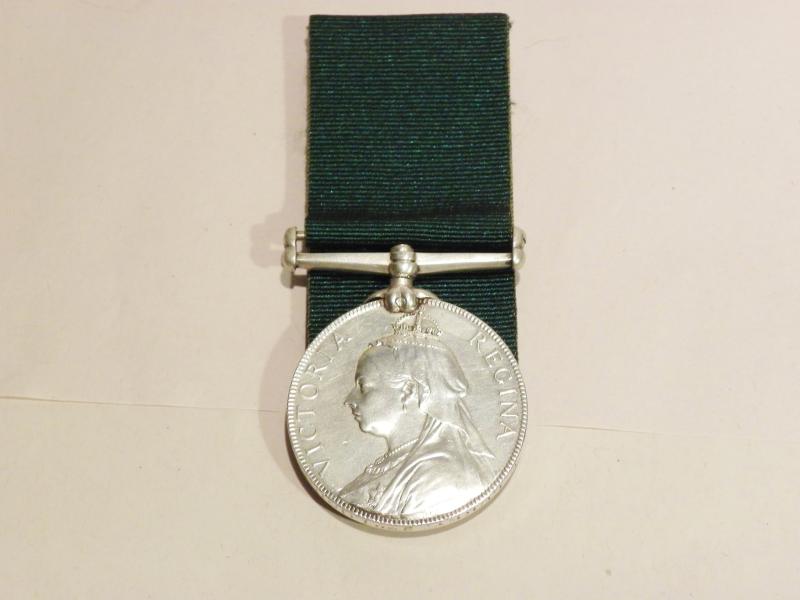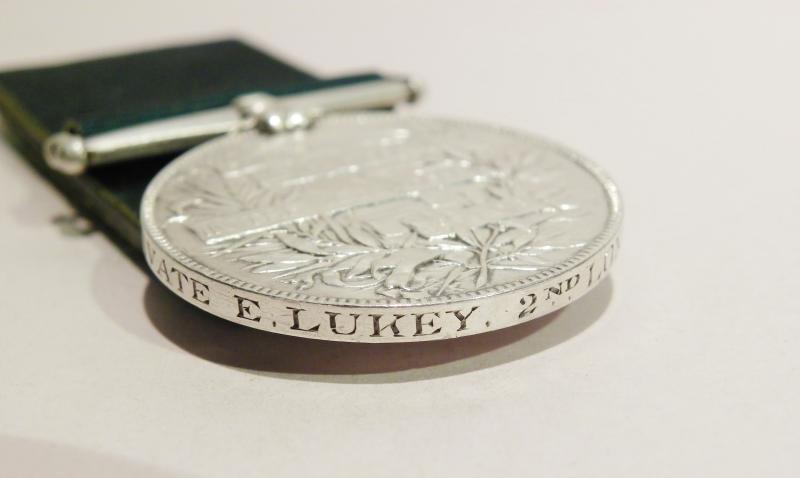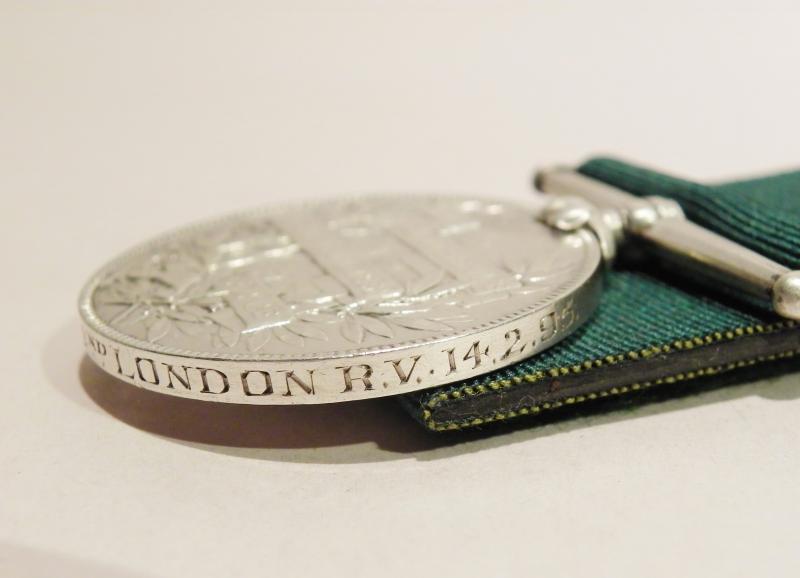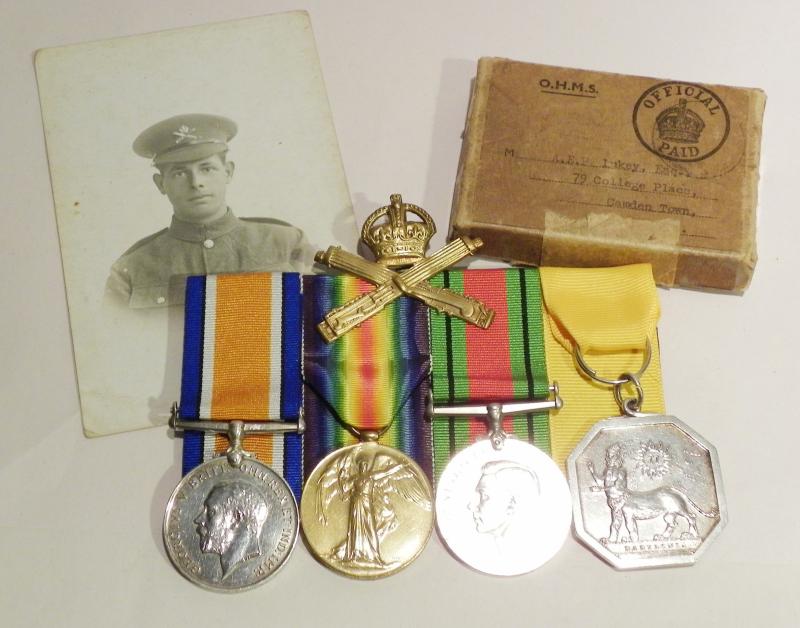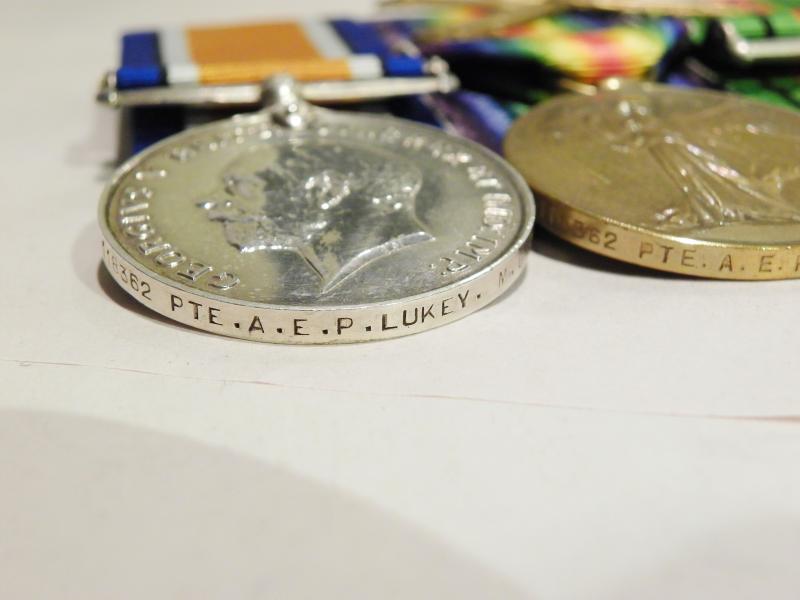Three Generation Family Group to Lukey
A fantastic Victorian, WW1 & WW2 grandfather, father and son medals, now, this takes a little explaining so please bear with me.
The first medal, Victorian Volunteer Force Long Service medal, privately named to; No 7 Private Edward Lukey of the 2nd London Rifle Volunteers (dated) 14th January 1895. This medal was awarded for 20 years’ service in the volunteer forces. Edward Lukey enlisted around 1875, he worked has a Cloth Worker and was married to Francis and lived in Marylebone London. With a number as low as number 7 he must have been one of the first to enrol after the reforms of 1872 when the regiment was taken under the wing of the 48th Middlesex RVC. This medal is in superb condition and it is now court mounted.
WW1 group comprises of the British war and Victory medal correctly named to; 118362 Private Albert. E. P. Lukey. (son of Edward Lukey) Machine Gun Corps. WW2 Defence medal, unnamed as issued and a large very heavy solid silver sports medal with an image of Ugallu the storm demon with a sun at his back with the number 17 within it and at the bottom ‘Babylonia’. On the reverse is engraved ‘Pte A Lukey 1st Tug of war’. All medals have been court mounted obviously within the last ten years or so and come with original cap badge and photograph of Albert in uniform. Plus box of issue for his defence medal with issue slip.
Albert Edward Lukey was born in London around 1884 and in civilian life, he was a wood polisher. He was probably drafted into the army in 1916 and found his way to the MGC. If the ’17’ on the tug of war medal is a unit or battalion, there was no 17 battalion or company of MGC fighting in Mesopotamia only the 17th Motor Machine corps. The 17th MGC was formed February 1918 and only served in France and I can find little information regarding the 17th MMGC battalion, only that later in the war they served under the command of General Sir Frederick Maude. Anglo-Indian troops advanced back up the River Tigris recapturing Kut and Baghdad on their way. This offensive, culminating in the Battle of Istabulat and the capture of Samarra, this was a great boost to the British war effort, although at a great cost. This man need more research and the information above only my opinion. Private Albert Lukey survived and discharged in the May of 1920. A lot of MMGC and Armoured car units stayed in Mesopotamia after the Armistice the Iraqi revolt devolved from several secret societies that had been formed in the region during 1918 and 1919.
WW2 Group of three comprising of 1939/45 star, Africa star and 1939/45 war medal, all court mounted unnamed as issued but with casualty medal issue slip named to 6916783 Rifleman A. E. Lukey. Also included is a WW2 era Rifle Brigade cap badge.
Rifleman Albert Edward Lukey born 1917 (the son of Albert E. P. Lukey) served with the 1st battalion Rifle Brigade; it was in England on the outbreak of the Second World War, originally part of the 1st Support Group, part of the 1st Armoured Division. In late April 1940, however, the battalion transferred to the newly created 30th Infantry Brigade and landed in France the following month within the British Expeditionary Force (BEF) but was lost at the defence of Calais, due to the lack of food water and ammunition, however the brigade slowed the German advance and enabled the Dunkirk evacuation to proceed. The battalion was reformed in the United Kingdom and became part of the 2nd Armoured Brigade of the 1st Armoured Division and took part in many battles in the North African Campaign which took place from 10th June 1940 to 13th May 1943. It included campaigns fought in the Libyan and Egyptian deserts. When the division arrived in Egypt in mid-November 1941, the latest British offensive Operation Crusader had already started. By the end of that year's December, Operation Crusader had concluded with an Axis withdrawal to western Libya. The 1st Armoured Division moved into eastern Libya, took over the front line and was reinforced with the 200th Guards Brigade. Apart from small infantry forces, the division was the only force within 100 miles of the front line. In early January 1942, the division was subjected to an aerial attack and on 21st January 1942, Axis forces attacked the 150-tank strong division and forced it to conduct a fighting withdrawal. The division, along with the rest of the Eighth Army, retreated until the army regrouped at Gazala in February. The division had lost 42 tanks in combat, with a further 30 damaged or abandoned. On 26 May 1942, Axis forces struck the Allied positions and initiated the Battle of Gazala which took place west of the port of Tobruk in Libya, from 26 May to 21 June 1942, the allies facing an enemy of German and Italian troops of over 80,000 men. Here Albert was probably taken prisoner by an Italian contingent around 21st January 1942 and he would have been placed in a pow camp in north Africa for a while before being shipped off to Italian-controlled territory, either to Italy or to Greece by ship, either on naval units or on homeward bound Italian merchant vessels. At the time there was a top secret British Submarine operation in progress off the coast of north Africa to stop munitions and supplies reaching the Axis fighting forces. This could be dangerous, since POW transports were not marked. Albert was probably put on board the Italian steam ship the Ariosto. The Ariosto was sunk, hit by two torpedoes, and going down after a few hours in the early hours of 15 February. As the prisoners were crammed into the hull of the ship nearly all souls were lost, Albert Lukey being just one. His death was not confirmed until March of 42. He is now remembered with honour at the Alamein Memorial although his death is recorded ‘at sea’.
All medals are in excellent condition and all come court mounted.
Along with the medals etc comes many pages of research including medal rolls, index card and commonwealth war graves certificate confirming above.
Code: 28438
275.00 GBP


